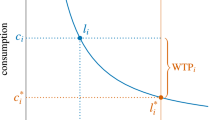Abstract
In many studies, health expectancies (HE) by relative socio-economic status have been calculated but the estimation of confidence intervals and the performance of tests of significance for differences in HE between sub-populations have been impeded by lack of variance estimation methods. Also in most scenarios, the sampling designs of the surveys from which prevalence of ill-health conditions are obtained have been ignored. This paper aims at presenting variance estimation techniques such as the bootstrap and the delta method taking account of the survey design. The study suggests that using the raw survey data and the Delta method while accounting for the survey design, gives better estimates for the variance compared to the bootstrap method and therefore is a highly recommended method for variance estimation of HE by relative socio-economic status.
Similar content being viewed by others
Explore related subjects
Discover the latest articles and news from researchers in related subjects, suggested using machine learning.References
Bone MR, Bebbington AC, Jagger C, Morgan K, Nicolaas G. Health expectancy and its uses. London: OPCS 1995, 1995.
Sanders BS. Measuring community health levels. Am J Public Health 1964;54:1063–70.
Sullivan DF. A single index of mortality and morbidity. HSMHA Health Rep. 1971;86:347–54.
Robine JM, Jagger C, Romieu I. Disability-free life expectancies for European Union countries. Genus 2001;57:89–101.
Wilkins R, Adams OB. Health expectancy in Canada, late 1970s: demographic, regional, and social dimensions. Am J Public Health 1983;73:1073–80.
Guralnik JM, Land KC, Blazer D, Fillenbaum GG, Branch LG. Educational status and active life expectancy among older blacks and whites. N Engl J Med. 1993;329:110–6.
Sihvonen AP, Kunst AE, Lahelma E, Valkonen T, Mackenbach JP. Socio-economic inequalities in health expectancy in Finland and Norway in the late 1980s. Soc Sci Med. 1998;47:303–15.
Cambois E, Robine JM, Hayard M. Social inequality in disability-free life expectancy in the French male population, 1980–1991. Demography 2001;38:513–24.
Bossuyt N, Gadeyne S, Deboosere P, Van Oyen H. Socio-economic inequalities in healthy expectancy in Belgium. Public Health 2004;118:3–10.
Perenboom RJM, van Herten LM, Boshuizen HC, van den Bos GAM. Life expectancy without chronic morbidity: trends in gender and socioeconomic disparities. Public Health Rep. 2005;120:46–54.
Hayes L, Berry G. Sampling variability of the Kunst-Mackenbach relative index of inequality. J Epidemiol Community Health 2002;56:762–765.
Robine JM, Romieu I, Cambois E. Health expectancy indicators. Bull World Health Organ. 1999;77(2):181–5.
Liberatos P, Link BG, Kelsey JL. The measurement of social class in epidemiology. Epidemiol Rev. 1988;10:87.
Chiang CL. The life table and its applications. Malabar, FL: Robert E Krieger Publishing Company; 1984.
Newman SC. A Markov process interpretation of Sullivan’s index of morbidity and mortality. Stat Med. 1988;7:787–94.
Pamuk ER. Social-class inequality in infant mortality in England and Wales from 1921 to 1980. Eur J Popul. 1988;4:1–21.
Efron B, Tibshirani R. An introduction to the bootstrap. New York: Chapman and Hall; 1993.
Oehlert GW. A note on the delta method. Am Stat 1992;46:27–9.
Molla M, Wagener D, Madans J. Summary measures of population health: methods for calculating healthy life expectancy. Healthy People 2010, Statistical Notes, 21; 2001
van Oyen H, Bossuyt N, Deboosere P, Gadeyene S,Tafforeau J. Differences in health expectancy indicators in Belgium by region. Arch Public Health 2002;60(6):341–62.
DeGroot MH () Probability and statistics, 2nd ed. Addison-Wesley; 1986. pp. 213–7.
van Oyen H, Tafforeau J, Hermans H, Quataert P, Schiettecatte E, Lebrun L Bellamammer. The Belgian health interview survey. Arch Public Health 1997;55:1–13.
De Bruin A, Picavet HS, Nosikov A. Health interview surveys: towards international harmonization of methods and instruments. Copenhagen: World Health Organisation; 1996.
Author information
Authors and Affiliations
Corresponding author
Appendix A: Estimation of variance of prevalence of ill health conditions
Appendix A: Estimation of variance of prevalence of ill health conditions
The following logistic regression model was fit to the data using the prevalence (π) of ill-health conditions as the response variable:
where βj, j = 0,1,2, ...,N represent parameters to be estimated from the data and x j , j = 1,2,3,,N represent the various predictor variables that can be incorporated into the model. These variables are the relative position on the socio-economic scale, age, sex and other variables depending on the research question.
The fitted model obtained from (4) is used to predict the prevalence of those at the top and the bottom of the socio-economic scale for various combinations of the predictor variables; e.g. for males between 25 and 34 years. Using the predicted prevalence and (1), the HE of persons at the top and bottom of the socio-economic scale is obtained.
The variance of the HE is obtained by first determining the variance of the predicted prevalence. The fitted model from (4) provides estimates for the variance (v) of the log odds (θ): Thus suppose \(\hat{\theta}=\hbox{log}(\hat{\pi}/(1-\hat{\pi}))\) and \(\hbox{var}(\hat{\theta})=v,\) then \(\hat{\pi}=\hbox{exp} (\hat{\theta})/(1+\hbox{exp} (\hat{\theta}))\) and the variance of the predicted prevalence according to the Delta method [17] is given by;
Rights and permissions
About this article
Cite this article
Abatih, E., Van Oyen, H., Bossuyt, N. et al. Variance estimation methods for health expectancy by relative socio-economic status. Eur J Epidemiol 23, 243–249 (2008). https://doi.org/10.1007/s10654-008-9227-5
Received:
Accepted:
Published:
Issue Date:
DOI: https://doi.org/10.1007/s10654-008-9227-5
Keywords
Profiles
- Herman Van Oyen View author profile




